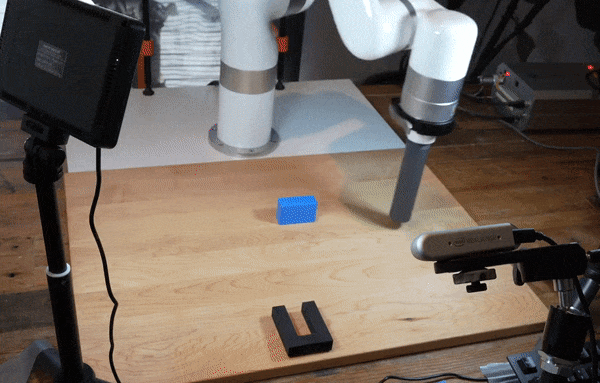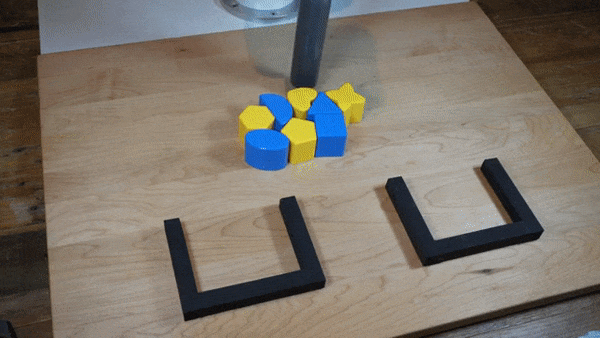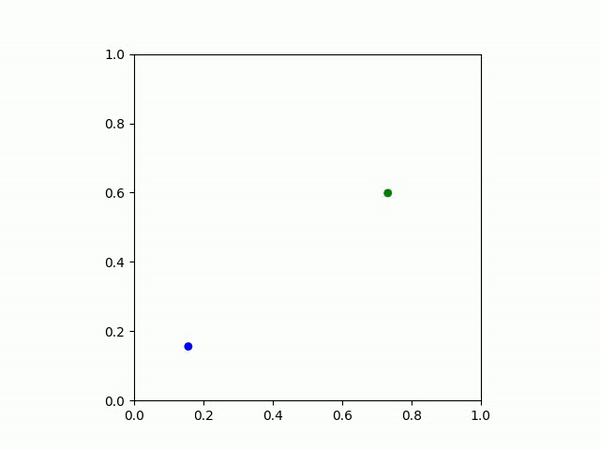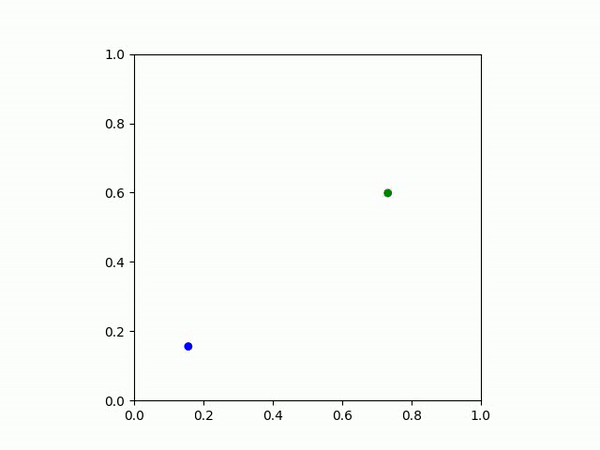This codebase contains the official implementation of the Implicit Behavioral Cloning (IBC) algorithm from our paper:
Implicit Behavioral Cloning (website link) (arXiv link)
Pete Florence, Corey Lynch, Andy Zeng, Oscar Ramirez, Ayzaan Wahid, Laura Downs, Adrian Wong, Johnny Lee, Igor Mordatch, Jonathan Tompson
Conference on Robot Learning (CoRL) 2021
 |
 |
|---|
We find that across a wide range of robot policy learning scenarios, treating supervised policy learning with an implicit model generally performs better, on average, than commonly used explicit models. We present extensive experiments on this finding, and we provide both intuitive insight and theoretical arguments distinguishing the properties of implicit models compared to their explicit counterparts, particularly with respect to approximating complex, potentially discontinuous and multi-valued (set-valued) functions. On robotic policy learning tasks we show that implicit behavioral cloning policies with energy-based models (EBM) often outperform common explicit (Mean Square Error, or Mixture Density) behavioral cloning policies, including on tasks with high-dimensional action spaces and visual image inputs. We find these policies provide competitive results or outperform state-of-the-art offline reinforcement learning methods on the challenging human-expert tasks from the D4RL benchmark suite, despite using no reward information. In the real world, robots with implicit policies can learn complex and remarkably subtle behaviors on contact-rich tasks from human demonstrations, including tasks with high combinatorial complexity and tasks requiring 1mm precision.
The code for this project uses python 3.7+ and the following pip packages:
python3 -m pip install --upgrade pip
pip install \
absl-py==0.12.0 \
gin-config==0.4.0 \
matplotlib==3.4.3 \
mediapy==1.0.3 \
opencv-python==4.5.3.56 \
pybullet==3.1.6 \
scipy==1.7.1 \
tensorflow==2.6.0 \
keras==2.6.0 \
tf-agents==0.11.0rc0 \
tqdm==4.62.2(Optional): For Mujoco support, see docs/mujoco_setup.md. Recommended to skip it
unless you specifically want to run the Adroit and Kitchen environments.
Step 1: Install listed Python packages above in Prerequisites.
Step 2: Run unit tests (should take less than a minute), and do this from the directory just above the top-level ibc directory:
./ibc/run_tests.shStep 3: Check that Tensorflow has GPU access:
python3 -c "import tensorflow as tf; print(tf.test.is_gpu_available())"If the above prints False, see the following requirements, notably CUDA 11.2 and cuDNN 8.1.0: https://www.tensorflow.org/install/gpu#software_requirements.
Step 4: Let's do an example Block Pushing task, so first let's download oracle data (or see Tasks for how to generate it):
cd ibc/data
wget https://storage.googleapis.com/brain-reach-public/ibc_data/block_push_states_location.zip
unzip block_push_states_location.zip && rm block_push_states_location.zip
cd ../..Step 5: Set PYTHONPATH to include the directory just above top-level ibc, so if you've been following the commands above it is:
export PYTHONPATH=$PYTHONPATH:${PWD}Step 6: On that example Block Pushing task, we'll next do a training + evaluation with Implicit BC:
./ibc/ibc/configs/pushing_states/run_mlp_ebm.shSome notes:
- On an example single-GPU machine (GTX 2080 Ti), the above trains at about 18 steps/sec, and should get to high success rates in 5,000 or 10,000 steps (roughly 5-10 minutes of training).
- The
mlp_ebm.ginis just one config, which is meant to be reasonably fast to train, with only 20 evals at each interval, and is not suitable for all tasks. See Tasks for more configs. - Due to the
--videoflag above, you can watch a video of the learned policy in action at:/tmp/ibc_logs/mlp_ebm/ibc_dfo/... navigate to thevideos/ttl=7dsubfolder, and by default there should be one example.mp4video saved every time you do an evaluation interval.
(Optional) Step 7: For the pybullet-based tasks, we also have real-time interactive visualization set up through a visualization server, so in one terminal:
cd <path_to>/ibc/..
export PYTHONPATH=$PYTHONPATH:${PWD}
python3 -m pybullet_utils.runServerAnd in a different terminal run the oracle a few times with the --shared_memory flag:
cd <path_to>/ibc/..
export PYTHONPATH=$PYTHONPATH:${PWD}
python3 ibc/data/policy_eval.py -- \
--alsologtostderr \
--shared_memory \
--num_episodes=3 \
--policy=oracle_push \
--task=PUSHYou're done with Quickstart! See below for more Tasks, and also see docs/codebase_overview.md and docs/workflow.md for additional info.
In this task, the goal is for the agent (black dot) to first go to the green dot, then the blue dot.
| Example IBC policy | Example MSE policy |
|---|---|
 |
 |
We can either generate data from scratch, for example for 2D (takes 15 seconds):
./ibc/ibc/configs/particle/collect_data.shOr just download all the data for all different dimensions:
cd ibc/data/
wget https://storage.googleapis.com/brain-reach-public/ibc_data/particle.zip
unzip particle.zip && rm particle.zip
cd ../..Let's start with some small networks, on just the 2D version since it's easiest to visualize, and compare MSE and IBC. Here's a small-network (256x2) IBC-with-Langevin config, where 2 is the argument for the environment dimensionality.
./ibc/ibc/configs/particle/run_mlp_ebm_langevin.sh 2And here's an idenitcally sized network (256x2) but with MSE config:
./ibc/ibc/configs/particle/run_mlp_mse.sh 2For the above configurations, we suggest comparing the rollout videos, which you can find at /tmp/ibc_logs/...corresponding_directory../videos/. At the top of this section is shown a comparison at 10,000 training steps for the two different above configs.
And here are the best configs respectfully for IBC (with langevin) and MSE, in this case run on the 16-dimensional environment:
./ibc/ibc/configs/particle/run_mlp_ebm_langevin_best.sh 16
./ibc/ibc/configs/particle/run_mlp_mse_best.sh 16
Note: the _best config is kind of slow for Langevin to train, but even just ./ibc/ibc/configs/particle/run_mlp_ebm_langevin.sh 16 (smaller network) seems to solve the 16-D environment pretty well, and is much faster to train.
We can either generate data from scratch (~2 minutes for 2,000 episodes: 200 each across 10 replicas):
./ibc/ibc/configs/pushing_states/collect_data.shOr we can download data from the web:
cd ibc/data/
wget https://storage.googleapis.com/brain-reach-public/ibc_data/block_push_states_location.zip
unzip 'block_push_states_location.zip' && rm block_push_states_location.zip
cd ../..Here's reasonably fast-to-train config for IBC with DFO:
./ibc/ibc/configs/pushing_states/run_mlp_ebm.shOr here's a config for IBC with Langevin:
./ibc/ibc/configs/pushing_states/run_mlp_ebm_langevin.shOr here's a comparable, reasonably fast-to-train config for MSE:
./ibc/ibc/configs/pushing_states/run_mlp_mse.shOr to run the best configs respectfully for IBC, MSE, and MDN (some of these might be slower to train than the above):
./ibc/ibc/configs/pushing_states/run_mlp_ebm_best.sh
./ibc/ibc/configs/pushing_states/run_mlp_mse_best.sh
./ibc/ibc/configs/pushing_states/run_mlp_mdn_best.shcd ibc/data/
wget https://storage.googleapis.com/brain-reach-public/ibc_data/block_push_visual_location.zip
unzip 'block_push_visual_location.zip' && rm block_push_visual_location.zip
cd ../..Here is an IBC with Langevin configuration which should actually converge faster than the IBC-with-DFO that we reported in the paper:
./ibc/ibc/configs/pushing_pixels/run_pixel_ebm_langevin.shAnd here are the best configs respectfully for IBC (with DFO), MSE, and MDN:
./ibc/ibc/configs/pushing_pixels/run_pixel_ebm_best.sh
./ibc/ibc/configs/pushing_pixels/run_pixel_mse_best.sh
./ibc/ibc/configs/pushing_pixels/run_pixel_mdn_best.shThe D4RL human demonstration training data used for the paper submission can be downloaded using the commands below. This data has been processed into a .tfrecord format from the original D4RL data format:
cd ibc/data && mkdir -p d4rl_trajectories && cd d4rl_trajectories
wget https://storage.googleapis.com/brain-reach-public/ibc_data/door-human-v0.zip \
https://storage.googleapis.com/brain-reach-public/ibc_data/hammer-human-v0.zip \
https://storage.googleapis.com/brain-reach-public/ibc_data/kitchen-complete-v0.zip \
https://storage.googleapis.com/brain-reach-public/ibc_data/kitchen-mixed-v0.zip \
https://storage.googleapis.com/brain-reach-public/ibc_data/kitchen-partial-v0.zip \
https://storage.googleapis.com/brain-reach-public/ibc_data/pen-human-v0.zip \
https://storage.googleapis.com/brain-reach-public/ibc_data/relocate-human-v0.zip
unzip '*.zip' && rm *.zip
cd ../../..Here are the best configs respectfully for IBC (with Langevin), and MSE: On a 2080 Ti GPU test, this IBC config trains at only 1.7 steps/sec, but it is about 10x faster on TPUv3.
./ibc/ibc/configs/d4rl/run_mlp_ebm_langevin_best.sh pen-human-v0
./ibc/ibc/configs/d4rl/run_mlp_mse_best.sh pen-human-v0The above commands will run on the pen-human-v0 environment, but you can swap this arg for whichever of the provided Adroit/Kitchen environments.
Here also is an MDN config you can try. The network size is tiny but if you increase it heavily then it seems to get NaNs during training. In general MDNs can be finicky. A solution should be possible though.
./ibc/ibc/configs/d4rl/run_mlp_mdn.sh pen-human-v0
For the tasks that we've been able to open-source, results from the paper should be reproducible by using the linked data and command-line args below.
| Task | Figure/Table in paper | Data | Train + Eval commands |
|---|---|---|---|
| Coordinate regression | Figure 4 | See colab | See colab |
| D4RL Adroit + Kitchen | Table 2 | Link | Link |
| N-D particle | Figure 6 | Link | Link |
| Simulated pushing, single target, states | Table 3 | Link | Link |
| Simulated pushing, single target, pixels | Table 3 | Link | Link |
If you found our paper/code useful in your research, please consider citing:
@article{florence2021implicit,
title={Implicit Behavioral Cloning},
author={Florence, Pete and Lynch, Corey and Zeng, Andy and Ramirez, Oscar and Wahid, Ayzaan and Downs, Laura and Wong, Adrian and Lee, Johnny and Mordatch, Igor and Tompson, Jonathan},
journal={Conference on Robot Learning (CoRL)},
month = {November},
year={2021}
}
